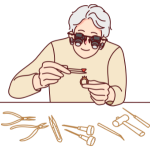Rubies can be natural or treated, and the distinction matters. Heat treated stones have been exposed to high temperatures to reduce imperfections like rutile inclusions or fissures. The result is a gem with improved colour and clarity.
While the treatment process is standard and legal, it changes how we assess the gem’s value. Untreated rubies, prized for their rarity and unaltered crystal structure, often command a premium.
Differences Between Heat-Treated and Untreated Rubies
| Feature | Unheated Rubies | Treated Rubies |
|---|---|---|
| Treatment | No heat or chemical enhancement | Heated (often >1000°C) to enhance clarity/color |
| Color | Natural; may be uneven or slightly purplish | Enhanced; more vivid and uniform red |
| Clarity | Includes visible inclusions | Clarity improved by melting or reducing inclusions |
| Value | Higher per carat; collector’s item | Lower price per carat; better availability |
| Availability | Rare; limited supply | Widely available in the market |
| Durability | Naturally strong; untreated | Durable if properly treated |
| Visual Appeal | Natural beauty; less uniform | Clean, bright, often flawless-looking |
| Use Case | Investment-grade jewelry | Everyday jewelry and mass-market rings |
Value
Untreated rubies are rarer and usually more expensive per carat. Their value comes from their natural state and limited availability. Treated rubies are more readily available and affordable, especially in commercial ruby jewelry.
Durability
Heat treatment does not weaken a ruby. In fact, properly heated rubies can be just as durable as untreated ones. However, some extreme treatments, like lead glass filling, can lower durability.
Appearance
Treated rubies often show a more uniform and vibrant red hue, sometimes resembling the desirable “pigeon blood red.” Untreated rubies may have a slightly purplish tint or show uneven coloration, but their natural appearance is preferred by some collectors.
Inclusions
Untreated rubies retain natural inclusions, like rutile silk or crystal fractures. These inclusions are clues to origin and authenticity. Heat-treated rubies often show fewer inclusions because the heating process dissolves or modifies them.
Buyer Perception
Many buyers prefer untreated rubies for their rarity and natural appeal. Treated and untreated rubies both have their place in the market, but untreated ones are often seen as a better investment.
Lab Reports
A lab report will indicate the type of treatment a ruby has undergone. Reputable gemology labs such as GIA or GRS clearly mark whether a ruby is unheated vs heated, glass-filled, or subject to flux treatment. Properly disclosed treatment is an accepted practice in the gemstone industry.
What are Unheated Rubies?
These are natural rubies that have not gone through any heating or artificial improvement. They are kept in their original state, just as they were found in the mine.
Unlike stones that undergo high-temperature processing to adjust their appearance, these remain chemically and structurally unchanged. Internal features, like needle-like inclusions or tiny crystal traces, are preserved and help confirm the gem’s authenticity.
Because of their untouched nature, these rubies are far less common. Only a small fraction of stones on the market fall into this category.
That rarity contributes to their premium pricing, especially in high-end jewelry and collector pieces.
Their color might not be perfectly uniform—some show subtle shifts in tone—but many buyers value this as a sign of origin, not a defect.
Treatment
No heat is applied to improve appearance. The stone remains in its raw, geological state.
Color
Hue can vary and sometimes shows natural zoning. These rubies are not artificially made redder.
Inclusions
Natural markers like silk patterns, crystal bits, or internal lines are intact and visible.
Market Value
Due to low supply and natural condition, prices are often significantly higher than for modified stones.
Availability
Most gems sold today are enhanced. Unaltered rubies are harder to find and come mostly from specific regions like Myanmar or Sri Lanka.
Appearance
Though they may lack perfect uniformity, these stones offer individuality and character that many collectors prefer.
What are Heated Rubies?
Heated rubies are natural gemstones that have undergone a high-temperature treatment process to improve their appearance.
This widely accepted practice involves exposing the ruby to temperatures above 1000°C, sometimes with additives like beryllium or flux.
The goal is to enhance the colour of rubies, reduce visible imperfections, and increase the clarity of the ruby. After heating, the stone is cooled to stabilize the changes made to its crystal structure.
Treatment
The treatment of rubies through heating is the most common enhancement in the gemstone industry. It is used to dissolve silk-like inclusions and even out the color. No synthetic materials are added unless specified (e.g., in glass-filled rubies).
Color
The heat-treated process improves a ruby’s red tone, often bringing out more intense or uniform hues. Many heat-treated rubies show vibrant, commercial-quality color that appeals to mainstream buyers.
Clarity
This type of ruby treatment also improves clarity by dissolving or reducing internal flaws. Some stones, especially those with rutile silk, become more transparent after heating.
Availability
Heated rubies make up the vast majority of rubies available on the market. Mined rubies with poor visual quality are often selected for heating. Rubies are found in countries like Myanmar, Mozambique, and Sri Lanka before being sent for processing.
Visual Appeal
Once cut and polished, heated rubies can show exceptional brilliance. The treatment improves both color and clarity, resulting in a gem that’s beautiful and durable for everyday wear.
Why Unheated Rubies Are So Valuable?
Unheated rubies are rare. They are not exposed to high temperatures or any enhancement. The ruby’s color, inclusions, and crystal structure remain untouched.
Most rubies in the market are treated to improve clarity and color. Heat-treated rubies are more readily available and cost less.
The value of rubies is determined by rarity and authenticity. Natural rubies are known to hold higher value per carat weight.
Collectors prefer unheated rubies for investment and high-end ruby engagement jewelry. Their appearance may be less perfect but is fully natural.



Leave a Reply